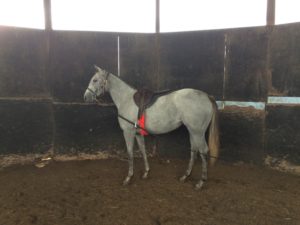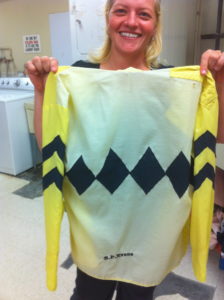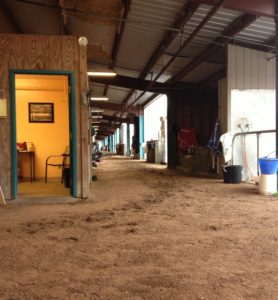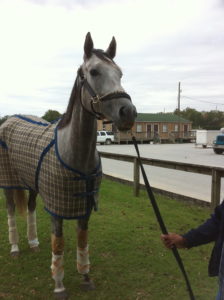A hotwalker is not a person who struts the corner on the wrong side of town, when the trainer tells you to “shank that horse” he is not telling you to stab the horse with a blade, and “that jockey has the bug” certainly doesn’t mean he is terminally ill. Its got a beautiful backside is not a discreet comment about your derrière and “meet me by the window” does not mean go to the closest source of daylight.
The racetrack is full of slang, jargon, vernacular, and literally hundreds of words and phrases whose use is foreign to everyday horse lovers and the general public. One could make a whole dictionary of words, I ain’t got time for that but here are some favorites.
Backside: The private stable area where the horses live on the racetrack grounds
Back-tracking: Exercising the horse clockwise along the outside rail of the racetrack. Also known as going “the wrong way”. Many horses warm up for a gallop or breeze by jogging (a gait faster than a walk and slower than a gallop) backtrack or they jog backtrack a mile or two as their light exercise for that day.
Blinkers: A little hooded-looking piece of attire worn on the horse’s head and face with plastic attachments blocking the horse’s ability to look behind him or too much to the sides. The idea is to keep the horses focus ahead and on the finish line. The cups diminish distraction and keep the horse on a straight path down the track.

A young Thoroughbred getting broke to ride.
Breaking: The process of training a horse to accept a rider and obey basic commands while being ridden. Also the action of blasting out of the starting gate like they do at the beginning of a race, breaking from the gate.
Bug-boy or Bug: A jockey or jockette who is in his or her first year of riding races at a sanctioned racetrack. “Having the Bug” refers to a 10-pound, seven pound, or five pound weight allowance. The weight allowances differ depending on the state, but the whole idea is to give beginning riders a break so trainers have an incentive to use them. The break in weight can make up for the rider’s lack of experience and could ultimately help a horse win in a race where it otherwise would not have.
Bullet: The fastest workout of the day going a specific distance. The bullet will have a black dot next to the recorded workout in the Daily Racing Form.
Claimer or Running for a tag: A horse that is entered in a race with a pre-specified purchase price named. Trainers and owners can purchase the horse out of the race for that price. Claiming races are a way of creating level or somewhat level competition. You can claim as horse for as little as $2,500 or as much as $100,000!

A vintage pair of silks, or colors, from the late Edward P. Evans, these were found in the jocks room at Parx in Pennsylvania.
Colors: Another name for the jockey’s brightly colored silks, representing the owner or partnership that owns the horse.
Common: A slang term used to describe a horse that doesn’t want to win a race! “That colt is so talented he could win any race if he wasn’t so common.”
Distaff: A race for fillies and mares.
Dogs: Dogs are traffic cones! Dogs are placed on the track to change the training boundaries. For example, dogs would be placed down the middle path of the track for horses breezing on the turf. By working around the dogs, as opposed to the normal place along the inside rail, the inside racing paths are not destroyed during practice.
Drop the slip: When claiming a horse, a claim slip is filled out and signed by a trainer authorized to claim a horse (meaning the money for the claim is in the account), and the slip is dropped into a locked box before the claiming race begins. All claims for that race are collected in that box and if you have a typo, wrong date, or name misspelled the claim will be tossed out and you will not be awarded the horse.
Furlong: An eighth of a mile. A unit of measurement commonly used to describe racing and breezing distances and measured by poles placed in 1/16 mile intervals around the racetrack oval.
Gap: A break in the fence line where horses and riders can enter and exit the track during morning training. If a naughty horse “makes the gap” that means they take the rider on an out-of-control path straight off the racetrack, no bueno!
Gelding: A castrated male horse.
Get tied on: Put your feet in the stirrups; get your knot in the reins tied, make sure your saddle is on tight and then hold on rider cause this horse is going to be frisky!
Guinea Stand: A high stand on the backside where grooms watch the races and trainers can watch their horses work while cackling with each other like hens in a henhouse.

Green horse? Not. Exactly.
Green horse: An inexperienced horse. This can describe the horse in general or a specific behavior for example: “He was green in the gate”, which means the horse had no experience with the starting gate.
Hit the board: When a horse finishes first, second, or third in a race.
Hotwalker: A person who hand-walks horses to cool them out after training or to simply stretch their legs for the lightest form of exercise.
Lugging (in/out): A horse who pulls towards the inside or outside rail. In its most minimal form, this can be annoying and cause the rider some degree of discomfort but in an extreme case, lugging is dangerous. A horse lugging out on the turn of a race can dart across traffic causing a serious accident or take himself and his rider all the way out over the outside rail in a disastrous crash.
Maiden: A horse that has never won a race.
On the muscle: When a horse is pulling its rider around the track or pulling its hotwalker around the shedrow. This horse is feeling frisky, fit, and full of life, probably needs to race soon!
Pony Horse: A regular-sized horse that accompanies the racehorses during morning training, acts as a taxi for a trainer who wants to see his or her horses train up close, and is used to warm-up and escort racehorses to the starting gate in the afternoon. Many pony horses are Thoroughbred ex-racehorses.
Racetracker: A person who works on the backside of the racetrack, a term that encompasses a way of life. “Once a racetrack, always a racetracker.”
Ruled Off: You are no longer allowed to step foot on racetrack grounds, you have done something pretty bad, maybe you have been caught stealing toilet paper from the track bathroom or maybe you have killed someone. Even horses can get ruled off the track if their behavior is so severe they become a danger to others.

Inside the barn or shedrow.
Shedrow: Refers to the barn or stable. This word is usually used to describe the stable’s appearance or the management of the employees and horses. A couple examples would be “Your shedrow looks great” or “Joe sure runs a tight shedrow.”
Shank: A leather lead strap about eight feet long with a length of chain on the end used to help control a headstrong horse. Most racehorses are led with a shank at all times.

This horse is being handled with a shank.
Spit box: Also known as the test barn. Race winners must report to the spit box for post-race drug testing.
String: A group of horses kept at one track. For example, if trainer John Smith had five strings that would mean he has five groups of horses at different tracks.
The window: The place to go to make or cash a bet. Betting windows are all over inside of the racetrack grandstand, clubhouse, and at Keeneland they even have drive thru betting windows.

Expensive trip to the window!
Tongue-tie: A piece of cloth used to tie a horses tongue down during training or racing. Tying the tongue helps the horse breath more freely and keeps the tongue under the bit.
Tow-ring: A slang term for the outdoor oval area used to cool out horses.
Valet: The guy, or sometimes gal, who get the jockey’s silks and other equipment ready for each race and helps the trainer saddle the horse for the race. Not pronounce val-aaaaaaaayyyy like the guy that parks your car but pronounced just as it’s spelled.
Whoa-back (Ho-Back): Heard all over every track, this is shouted to warn the person walking or riding behind you that you are coming to a halt. Riders and hotwalkers use these words frequently.
Workout, Work, or Breeze: A quick, timed length of exercise. This is about ¾ race speed at any distance from 1/8 of a mile to an entire mile. Works are used to prepare a horse to race and to keep a horse fit between races.

